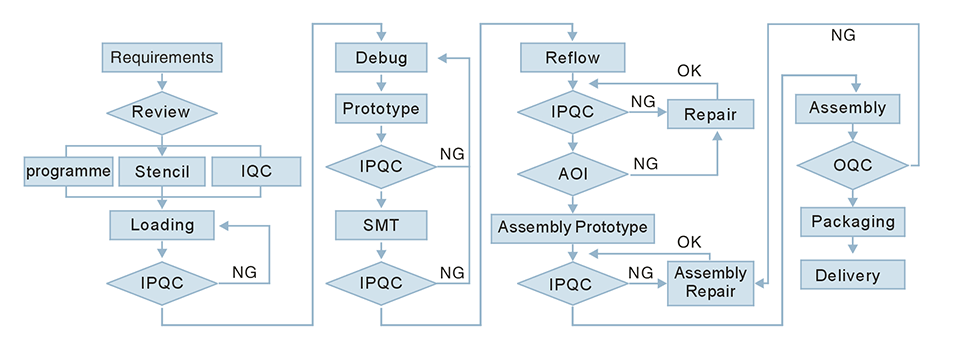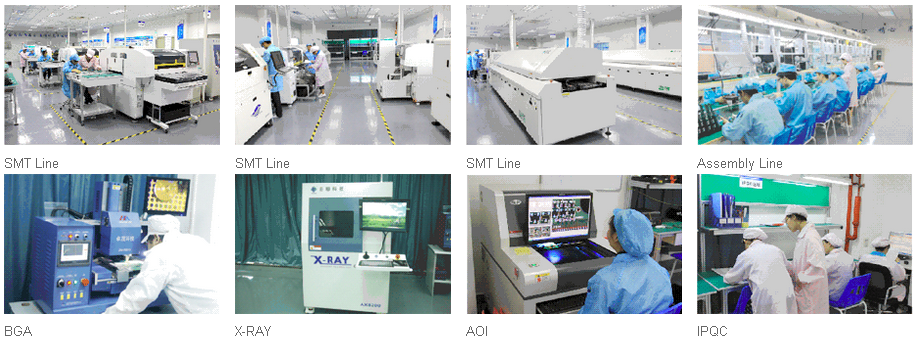How does the EDADOC PCBA factory work?
<<BackSource:Edadoc Time:2016/2/25 0:00:00
Printed circuit board assembly (PCBA) is the process of soldering or assembly of electronic components to a PCB or printed circuit board. A circuit board prior to assembly of electronic components is known as PCB. Once electronic components are soldered, the board is called Printed Circuit Board Assembly (PCBA).
Before assembly, we need PCBs and electronic components. Manufacturing printed circuit boards involve several processes including PCB designing and creating PCB prototype. Once a PCB is ready, electronic components need to be soldered onto a PCB before it can be used in any electronic equipment or gadget. This assembly of electronic components depends on type of circuit board, type of electronic components and purpose of the circuit board.
This article would like to show you how does the EDADOC PCBA factory work with 12 SMT lines?

Materials prepare: As a project is initiated, our engineer begin to program and prepare the stencil according to requirements. At the same time, IQC will check the parts’ quality including parts’ quantity, color, size and so on. Generally speaking, some PCBs will be baked before put them to SMT lines
Resistor value and capacitor value check: If everything is fine of the above step, SMT can be placed. But prior to first piece confirmation, Edadoc engineers will solder resistors and capacitors on a board with a two-sided tape. This is because solder paste will affect resistor value and capacitor value measurement accuracy. After the board soldered and IPQC confirmed all values are fine, so we can start to prototype.
Prototype(first piece confirmation):Before mass production, we need to prototype first, if everything of the first piece is fine, SMT lines can be placed formally, or it should be reworked or repaired.
SMT-mass production: All electronics components and PCBs with solder paste are prepared for this project on solder mounters. Solder mounters begin to work efficiently.
Reflow: Once all soldered boards are confirmed ok by IPQC, the next stage of the assembly is pass them through the reflow soldering machine. In Edadoc, we also have wave soldering machines.
AOI: After reflow soldering, boards will be putted into AOI machines for defect detection. IPQC also will check them again, If any fault or solder joint is found, it is sent for rework.
X-ray: Some boards are required to check by X-ray. In Edadoc, for mass production, we’ll offer X-ray check. For small volume projects, X-ray check will be charged for extra fee.
Test: Some clients may require us to test all boards before they leave the factory. What we can do is offering workers and PC devices. Clients should offer the test method or other test fixtures.
Product assembly: If clients need products assembly, Edadoc also can meet their requirements. But it is another story, we also need prepare materials, the first device also needs to be confirmed before assembly lines start to mass production. After assembly, QC and IPQC need to inspect all devices. If clients require us to test all products, we can also offer workers and PC devices.
Packing and shipping: Actually, packing is the last step on products assembly lines. The final stage is shipping products to our customers. So far, the whole PCBA process will be finished. All packing and shipping methods will follow clients’ requirement strictly.
Edadoc PCB assembly and production processes are generally optimized to ensure very low levels of defects, and in this way produce the highest quality product. In view of the number of components and solder joints in today's products, and the very high demands placed on quality, the operation of this process is critical to the success of the products that are manufactured. Edadoc PCBA factory devoted to cooperate with our clients, thus offers great product experience to end customers.

Before assembly, we need PCBs and electronic components. Manufacturing printed circuit boards involve several processes including PCB designing and creating PCB prototype. Once a PCB is ready, electronic components need to be soldered onto a PCB before it can be used in any electronic equipment or gadget. This assembly of electronic components depends on type of circuit board, type of electronic components and purpose of the circuit board.
This article would like to show you how does the EDADOC PCBA factory work with 12 SMT lines?

Resistor value and capacitor value check: If everything is fine of the above step, SMT can be placed. But prior to first piece confirmation, Edadoc engineers will solder resistors and capacitors on a board with a two-sided tape. This is because solder paste will affect resistor value and capacitor value measurement accuracy. After the board soldered and IPQC confirmed all values are fine, so we can start to prototype.
Prototype(first piece confirmation):Before mass production, we need to prototype first, if everything of the first piece is fine, SMT lines can be placed formally, or it should be reworked or repaired.
SMT-mass production: All electronics components and PCBs with solder paste are prepared for this project on solder mounters. Solder mounters begin to work efficiently.
Reflow: Once all soldered boards are confirmed ok by IPQC, the next stage of the assembly is pass them through the reflow soldering machine. In Edadoc, we also have wave soldering machines.
AOI: After reflow soldering, boards will be putted into AOI machines for defect detection. IPQC also will check them again, If any fault or solder joint is found, it is sent for rework.
X-ray: Some boards are required to check by X-ray. In Edadoc, for mass production, we’ll offer X-ray check. For small volume projects, X-ray check will be charged for extra fee.
Test: Some clients may require us to test all boards before they leave the factory. What we can do is offering workers and PC devices. Clients should offer the test method or other test fixtures.
Product assembly: If clients need products assembly, Edadoc also can meet their requirements. But it is another story, we also need prepare materials, the first device also needs to be confirmed before assembly lines start to mass production. After assembly, QC and IPQC need to inspect all devices. If clients require us to test all products, we can also offer workers and PC devices.
Packing and shipping: Actually, packing is the last step on products assembly lines. The final stage is shipping products to our customers. So far, the whole PCBA process will be finished. All packing and shipping methods will follow clients’ requirement strictly.
Edadoc PCB assembly and production processes are generally optimized to ensure very low levels of defects, and in this way produce the highest quality product. In view of the number of components and solder joints in today's products, and the very high demands placed on quality, the operation of this process is critical to the success of the products that are manufactured. Edadoc PCBA factory devoted to cooperate with our clients, thus offers great product experience to end customers.





